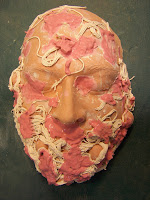 |
| James's Face |
Over 15 years ago, after my Dad died, I started working on a concept relating to the Seven Deadly Sins. At the time, had been doing a lot of work with series of masks; I had even had a one-woman show at Planet Ant Coffee House (now Planet Ant Theater) in Hamtramck consisting solely of the masks I had created in the three years of pottery instruction I had had at that point in time.
I'd be fooling myself (and no one else) if I thought there was no correlation between my father's recent demise and the birth of this concept. I was in a pretty morbid (in a lot of ways - personally, professionally, psychologically) place in my life - and what does any artist do with that sort of stuff?
Anyway, I started working on this idea in 1996, while I was working at a place called IRI, where I met my now-good-friend James, who was the company's IT person and, in addition to being rocky smart, culturally attuned and utterly devoted to his family, weighed, well, quite a lot at the time.
 |
| Part of the Extruded Pasta and Meatballs |
James, being James and possessed of a wide-ranging creative sensibility, provided a useful counterpoint to my musings on what was going to be a very big piece - eight (yes, that's right - eight) cabinets with doors (so-called to tie in with the classic 1920 film,
The Cabinet of Dr. Caligari) made using recovered wine crates (the kind that hold four or so bottles of wine). The entire piece was actually an installation, to be honest. I had already decided that I would stain the exteriors all of the boxes black (or ebony) so they would look relatively uniform and innocuous on the outside. I also planned to make my own door pulls featuring hand-incised images of
momento mori (iconographical reminders of death, such as an hourglass, clock face, extinguished candle, fading flower, rotten fruit - you get the idea). I planned to decoupage the inside of each cabinet with pertinent paper-based imagery and affixe a
raku "nameplate" inside at the top of each one, above a mask conveying that particular vice. Some of the pieces were more challenging to conceptualize (and some still are); others were relatively easy.
 |
| The Pasta Finished |
One day, James and I were discussing what I could do with "Gluttony". I wanted a strong contrast between the plain matte black stain of the exterior of the cabinet and thought a collage of pictures of pasta dishes - with their strong colors and textures - would work. James (who weighed over 400 pounds at the time) chimed in that I should use the face of a really fat person (he was not disingenuous about his physique) for the mask and put pasta, meatballs and sauce all over it. I observed that I didn't know any fat people, which was met with a look of mingled affection and exasperation.
Needless to say, I did make a cast of James's face; you can see the piece I pulled from it in the top picture here. I went ahead and used my Rovin RO-23 Peach Stoneware for the face itself because I planned to use an opaque glaze from my first pottery teacher and I prefer this clay for most of my work. I also planned to use that clay body for the "meatballs", as I planned to stain them using Burnt Umber, for a different type of matte finish. After cleaning up the face and putting in holes from which to hang it once the piece was finished, I began the process of adding the "pasta", "meatballs" and "sauce".
 |
| The Mask, Completely Fabricated |
Because I didn't want to have to glaze the "pasta" and wanted to be able to use glazes from the Amaco celebration series for the "sauce", I decided to use Rovin RO-77 Lite Stoneware for those parts of the composition. I used my Mini Klay Gun extruder with the largest die for the pasta, having scored the face underneath. Once I got a good "base", I rolled meatball-sized balls of Peach Stoneware on burlap to give them some texture, cut them in half and applied them to the face, then added more extruded White Stoneware, this time scattered over the entire face.
The final touch was going to be the sauce. Using a pastry knife, I slung clumps of semi-liquid white stoneware slip slip at
the mask, randomly hitting it all over the pasta and exposed "skin". I made quite a mess all over my work area (including the floor) but I loved the effect - it conveyed the unbridled energy I was driving for as successfully as I could have wished.
Once I had made sure the hanging holes had not been covered in the fabrication process, I set the mask to dry, then bisque-fired it to Cone 06. Now it was ready to be glazed. I had been (relatively) careful about documenting the process, partly to include on this blog but also because I wanted James to see what I had done with his face. I actually saw him later on the day I fabricated the mask. He had had surgery in the intervening years and it was truly amazing to see how great he was looking - and he liked what I had done with our concept.






























